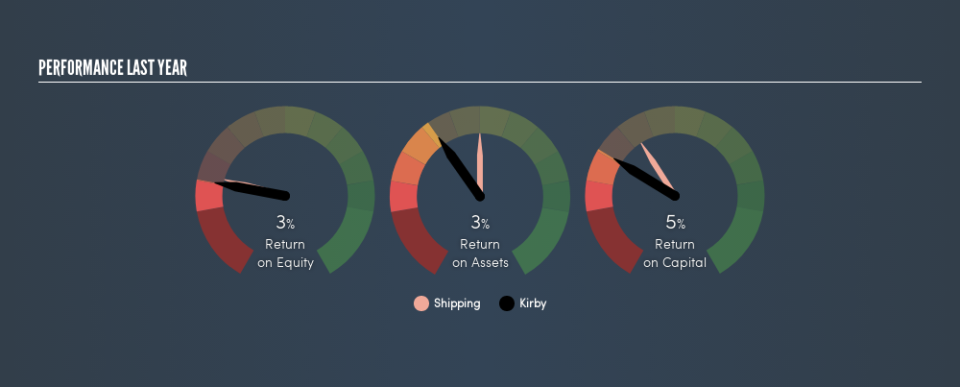Is Kirby Corporation (NYSE:KEX) Investing Effectively In Its Business?

Today we are going to look at Kirby Corporation (NYSE:KEX) to see whether it might be an attractive investment prospect. Specifically, we're going to calculate its Return On Capital Employed (ROCE), in the hopes of getting some insight into the business.
First up, we'll look at what ROCE is and how we calculate it. Next, we'll compare it to others in its industry. Last but not least, we'll look at what impact its current liabilities have on its ROCE.
Return On Capital Employed (ROCE): What is it?
ROCE measures the 'return' (pre-tax profit) a company generates from capital employed in its business. In general, businesses with a higher ROCE are usually better quality. In brief, it is a useful tool, but it is not without drawbacks. Renowned investment researcher Michael Mauboussin has suggested that a high ROCE can indicate that 'one dollar invested in the company generates value of more than one dollar'.
How Do You Calculate Return On Capital Employed?
The formula for calculating the return on capital employed is:
Return on Capital Employed = Earnings Before Interest and Tax (EBIT) ÷ (Total Assets - Current Liabilities)
Or for Kirby:
0.05 = US$284m ÷ (US$6.2b - US$526m) (Based on the trailing twelve months to June 2019.)
Therefore, Kirby has an ROCE of 5.0%.
Check out our latest analysis for Kirby
Is Kirby's ROCE Good?
When making comparisons between similar businesses, investors may find ROCE useful. We can see Kirby's ROCE is around the 5.0% average reported by the Shipping industry. Independently of how Kirby compares to its industry, its ROCE in absolute terms is low; especially compared to the ~2.7% available in government bonds. There are potentially more appealing investments elsewhere.
We can see that , Kirby currently has an ROCE of 5.0%, less than the 8.1% it reported 3 years ago. So investors might consider if it has had issues recently. The image below shows how Kirby's ROCE compares to its industry, and you can click it to see more detail on its past growth.
Remember that this metric is backwards looking - it shows what has happened in the past, and does not accurately predict the future. ROCE can be misleading for companies in cyclical industries, with returns looking impressive during the boom times, but very weak during the busts. ROCE is only a point-in-time measure. Future performance is what matters, and you can see analyst predictions in our free report on analyst forecasts for the company.
How Kirby's Current Liabilities Impact Its ROCE
Current liabilities are short term bills and invoices that need to be paid in 12 months or less. Due to the way ROCE is calculated, a high level of current liabilities makes a company look as though it has less capital employed, and thus can (sometimes unfairly) boost the ROCE. To counteract this, we check if a company has high current liabilities, relative to its total assets.
Kirby has total assets of US$6.2b and current liabilities of US$526m. Therefore its current liabilities are equivalent to approximately 8.4% of its total assets. Kirby has a low level of current liabilities, which have a negligible impact on its already low ROCE.
What We Can Learn From Kirby's ROCE
Nonetheless, there may be better places to invest your capital. Of course, you might find a fantastic investment by looking at a few good candidates. So take a peek at this free list of companies with modest (or no) debt, trading on a P/E below 20.
If you like to buy stocks alongside management, then you might just love this free list of companies. (Hint: insiders have been buying them).
We aim to bring you long-term focused research analysis driven by fundamental data. Note that our analysis may not factor in the latest price-sensitive company announcements or qualitative material.
If you spot an error that warrants correction, please contact the editor at editorial-team@simplywallst.com. This article by Simply Wall St is general in nature. It does not constitute a recommendation to buy or sell any stock, and does not take account of your objectives, or your financial situation. Simply Wall St has no position in the stocks mentioned. Thank you for reading.

 Yahoo Finance
Yahoo Finance 
